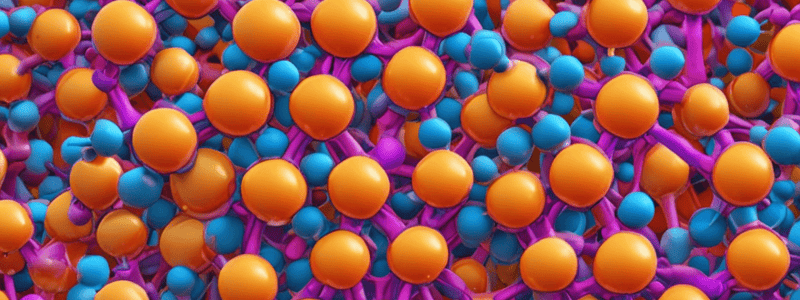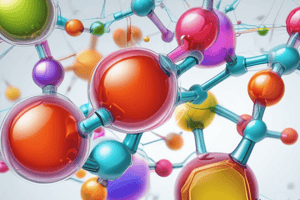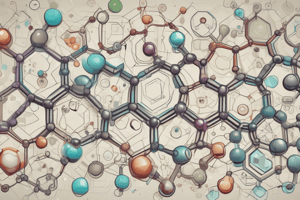Podcast
Questions and Answers
Which positions in the pyridine ring are most susceptible to nucleophilic substitution?
Which positions in the pyridine ring are most susceptible to nucleophilic substitution?
- 3 and 5
- 2 and 4 (correct)
- 2 and 6
- 1 and 3
What is an example of a powerful base that can displace pyridine's hydrogen atom?
What is an example of a powerful base that can displace pyridine's hydrogen atom?
- Ammonium ion
- Hydride ion (correct)
- Hydroxide ion
- Bromide ion
What is the name of the reaction involving amination by sodium amide on pyridine?
What is the name of the reaction involving amination by sodium amide on pyridine?
- Sandmeyer reaction
- Chichibabin reaction (correct)
- Friedel-Crafts reaction
- Grignard reaction
In nucleophilic aromatic substitution, what determines the rate of the overall reaction?
In nucleophilic aromatic substitution, what determines the rate of the overall reaction?
What type of compound can be used for alkylation or arylation in pyridine?
What type of compound can be used for alkylation or arylation in pyridine?
Which type of substitution mechanism for nucleophilic aromatic substitution is analogous to electrophilic substitution?
Which type of substitution mechanism for nucleophilic aromatic substitution is analogous to electrophilic substitution?
Which attack yields a carbanion that is a hybrid of structures IV, V, and VI?
Which attack yields a carbanion that is a hybrid of structures IV, V, and VI?
Why are the structures resulting from attacks on pyridine more stable than the corresponding ones for attack on a benzene derivative?
Why are the structures resulting from attacks on pyridine more stable than the corresponding ones for attack on a benzene derivative?
Why is structure III especially stable in nucleophilic substitution reactions?
Why is structure III especially stable in nucleophilic substitution reactions?
Why does nucleophilic substitution occur more rapidly on the pyridine ring than on the benzene ring?
Why does nucleophilic substitution occur more rapidly on the pyridine ring than on the benzene ring?
Which factor of pyridine makes it unreactive toward electrophilic substitution?
Which factor of pyridine makes it unreactive toward electrophilic substitution?
Why is pyridine highly reactive toward nucleophilic substitution?
Why is pyridine highly reactive toward nucleophilic substitution?
Which step in the nucleophilic substitution mechanism for pyridine determines the overall reaction rate?
Which step in the nucleophilic substitution mechanism for pyridine determines the overall reaction rate?
What type of intermediate is formed in the nucleophilic substitution mechanism for pyridine?
What type of intermediate is formed in the nucleophilic substitution mechanism for pyridine?
Which reaction involves the use of sodium amide as a nucleophile in pyridine substitution?
Which reaction involves the use of sodium amide as a nucleophile in pyridine substitution?
Which positions on the pyridine ring are most susceptible to nucleophilic substitution?
Which positions on the pyridine ring are most susceptible to nucleophilic substitution?
What type of compounds can be used for alkylation or arylation of pyridine through nucleophilic substitution?
What type of compounds can be used for alkylation or arylation of pyridine through nucleophilic substitution?
Which base is powerful enough to displace the hydrogen atom from pyridine in a nucleophilic substitution reaction?
Which base is powerful enough to displace the hydrogen atom from pyridine in a nucleophilic substitution reaction?
Which of the following statements about nucleophilic attack on pyridine is correct?
Which of the following statements about nucleophilic attack on pyridine is correct?
Why is structure III especially stable in nucleophilic substitution reactions?
Why is structure III especially stable in nucleophilic substitution reactions?
Which factor contributes to the higher reactivity of pyridine towards nucleophilic substitution compared to benzene derivatives?
Which factor contributes to the higher reactivity of pyridine towards nucleophilic substitution compared to benzene derivatives?
Which position in the pyridine ring is least susceptible to nucleophilic substitution?
Which position in the pyridine ring is least susceptible to nucleophilic substitution?
What is the primary factor that determines the rate of the overall nucleophilic substitution reaction on pyridine?
What is the primary factor that determines the rate of the overall nucleophilic substitution reaction on pyridine?
Why is pyridine unreactive towards electrophilic substitution?
Why is pyridine unreactive towards electrophilic substitution?
Flashcards are hidden until you start studying
Study Notes
Nucleophilic Substitution in Pyridine
- Pyridine ring resembles a benzene ring with strongly electron-withdrawing groups, facilitating nucleophilic substitution.
- Nucleophilic substitution occurs readily, particularly at the 2- and 4-positions.
- The reactivity of pyridine is so great that even the powerfully basic hydride ion, H-, can be displaced.
- Two important examples of this reaction are:
- Amination by sodium amide (Chichibabin reaction)
- Alkylation or arylation by organolithium compounds
Mechanism of Nucleophilic Aromatic Substitution
- Reaction proceeds by two steps, with the rate of the first step determining the overall reaction rate.
- Intermediate is negatively charged, unlike electrophilic substitution where it is positively charged.
- The ability of the ring to accommodate the charge determines the stability of the intermediate and the transition state.
Effects of Nitrogen Atom
- Electron withdrawal by the nitrogen atom makes pyridine unreactive toward electrophilic substitution.
- The same electronegativity of nitrogen makes pyridine highly reactive toward nucleophilic substitution.
- The nitrogen atom's ability to accommodate negative charge makes structures more stable.
Nucleophilic Attack at Different Positions
- Attack at the 4-position yields a carbanion that is a hybrid of structures I, II, and III.
- Attack at the 3-position yields a carbanion that is a hybrid of structures IV, V, and VI.
- Attack at the 2-position resembles attack at the 4-position.
- Structure III is especially stable, with the negative charge located on the electronegative nitrogen atom.
Studying That Suits You
Use AI to generate personalized quizzes and flashcards to suit your learning preferences.




